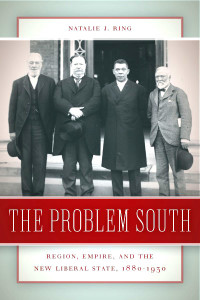Natalie Ring, The Problem South: Region, Empire, and the New Liberal State, 1880-1930 (Athens: University of Georgia Press, 2012) 288 pages.
Review by Sarah Bowman
Natalie Ring’s The Problem South adds to a rich vein of scholarship analyzing Northern views of the South.[i] Yet The Problem South does not so much exist within this tradition as it helps to expand its boundaries. Where previous work has focused on the “North-South binary” (10), Ring situates the discourse of region and nation squarely within an imperial framework. According to Ring, commentators on the region around the turn of the twentieth century saw the U.S. South as a backward region; they framed the project of reforming it as part of a global problem of uplifting colonial peoples. These imperially-informed notions of internal difference helped establish a definition of the nation itself as prosperous, progressive, and white. Thus, “patterns of domestic imperialism” (93) were essential to “the development of early twentieth-century liberalism and part of the process of nation-state formation” (3).
Bringing together postcolonial studies, U.S. southern regional studies, and scholarship on liberalism dramatically reshapes the story of U.S. national reconciliation. Scholars like Nina Silber and David Blight have argued that Northerners’ adoption of a romanticized view of the South and its past paved the way for reunion.[ii] In contrast, Ring finds that this process turned on visions of the South as a backward part of the nation in need of transformation: “the effort to reincorporate the New South into the nation was as much a process of rehabilitation and reform as one of political and cultural reunion” (5).
Arguing that scholars have relied too much on cultural texts to explain reconciliation, Ring aims to shift the focus to “material actions” on the “ground level” aimed at reforming the South (222 fn. 8). While this statement seems to dichotomize ideas and actions, in operation Ring skillfully interweaves the two, demonstrating the fundamental interconnections between conceptions of the South and actual attempts to change the region. The success of the endeavor is evidence of the fruitfulness of combining intellectual and social history.
To reach these conclusions, Ring has extensively mined books and periodical literature from the period, as well as the records of associations dedicated to Southern uplift, such as the Conference for Education in the South and the Rockefeller Sanitary Commission. The Problem South also draws on the archival collections of intellectuals and reformers, from the papers of Albert Bushnell Hart at Harvard to the Robert C. Ogden collection at the Library of Congress to the Seaman A. Knapp papers at Texas Tech.
Ring begins with a cogent conceptual and contextual overview of the “Southern problem” (18), with only brief mention of the historical development of Northern perceptions of the South. Starting in the 1880s, “New South ideologues” (21) trumpeted the industrial development of the region. Yet by the turn of the century criticisms of the region had begun to outweigh the prognostications of progress. The region’s poverty, illiteracy, and racial tensions prompted calls for its “readjustment” (43) into the nation’s industrial democracy. At the same time, the United States’ imperial domination of foreign peoples imparted a “transnational understanding of rural backwardness” (51) that framed southerners as yet another retrograde group in need of uplift.
Ring then examines how reformers used the concept of disease in the South as an “analytical tool” (59) by which to legitimate national efforts to remake the region. In the view of reformers, southern bodies sick with hookworm and pellagra made for a sick national body. Public health efforts to cure the ailments of the region could ensure the strength of the nation-state. Relying on medical advances suggesting that tropical colonial spaces were uniquely susceptible to disease, observers pictured the South as yet another “tropical Other” (84) whose pathologies threatened its white denizens with racial degeneration. Creating health at home buttressed America’s white identity for its project of Anglo-Saxon dominance abroad.
The third chapter analyzes the paradox of southern cotton. The crop embodied the South’s potential prosperity and its contribution to national greatness. Yet fluctuations in prices, the incursions of the boll weevil, and the South’s overreliance on the crop made for a poverty that prompted visions of the South as an “agricultural Other” (106)—a space more colonial than national. In response, federal reformers turned the South “into a laboratory for agricultural reform” (113) via the farm demonstration movement and the growing field of rural sociology. The region’s agricultural backwardness thus contributed to the process of state-building: “labeling a region backward and in need of economic reform helped generate support for modernization” (132).
Ring also traces efforts to uplift the poor whites of the South. The poverty and illiteracy of a large body of southern whites threatened their racial—and national—status at a time when white southerners were increasingly concerned with erecting social boundaries between the races. The apparent inferiority of this class enabled social scientific reformers to draw a contrast with the “civic competence and economic productivity” (138) they attributed to the nation-state. Ring charts this reformist logic of nation-building through several iterations: from efforts to eradicate child labor, to advocacy of industrial training, to attempts to further the education of southern whites.
The Problem South closes with a consideration of the South’s so-called “race question”: the problem of racial tensions (and violence) in such arenas as voting, labor, and social and sexual relations. The professionalization of social science provided a forum for a host of competing conceptions of the race question. Participants at conferences discussed the cause and meaning of “race friction” (186). Attention to the “mulatto problem” (193) troubled the fiction of the color line upon which white supremacy was based. Viewing the southern race question in a global framework, Ring argues, led reformers toward a “reliance on colonial strategies such as uplift and industrial education” (211) in their attempts to resolve race relations in the region.
Since Ring aims emphasize the distinctive aspects of southern progressivism (9; 223 fn. 15 and 16), the text might have done more to distinguish between northern and southern liberals, especially on the issue of race. A specific sectional perspective deeply tinged white southern racial moderates’ discussions of the so-called “race problem”. And while Ring asserts that New Southern proponents “often spoke as if the New South mirrored the North completely and was an entirely new creation” (31), New Southerners often took great pains to emphasize the continuities of the old South and the new.[iii] Additionally, Ring’s use of the term “New South ideologues” (21) implies dogmatism and rigidity, but the book does not make any explicit claims on the subject.
But these are minor points when considered in the light of the book’s critical contributions to the scholarship. The fact that Ring draws together so many issues and reformulates them in the process is a testament to the book’s wide-ranging utility. The Problem South is a must-read for scholars grappling with the intellectual history of the U.S. South, of U.S. nationalism, regionalism, imperialism, and liberalism.
[i] See for instance William R. Taylor, Cavalier and Yankee: The Old South and American National Character (New York: G. Braziller, 1961); Susan-Mary Grant, North Over South: Northern Nationalism and American Identity in the Antebellum Era (Lawrence: University Press of Kansas, 2000); and Nina Silber, The Romance of Reunion: Northerners and the South, 1865-1900 (Chapel Hill: University of North Carolina Press, 1993).
[ii] David W. Blight, Race and Reunion: The Civil War in American Memory (Cambridge, Mass.: Belknap Press of Harvard University Press, 2003).
Paul Gaston, The New South Creed: A Study in Southern Myth-Making (New York: Alfred A. Knopf, 1970), 159-166.
Sarah Bowman is a Ph.D. candidate in History at Yale University. Her dissertation, “Th e Problem of Yankeeland: White Southern Images of the North, 1865-1915,” examines how white Southerners reimagined the North in the half century following the Civil War. The dissertation argues that white Southerners’ narratives about the North were crucial to the reconstruction of southern identity and to national reconciliation after the war.
e Problem of Yankeeland: White Southern Images of the North, 1865-1915,” examines how white Southerners reimagined the North in the half century following the Civil War. The dissertation argues that white Southerners’ narratives about the North were crucial to the reconstruction of southern identity and to national reconciliation after the war.

0